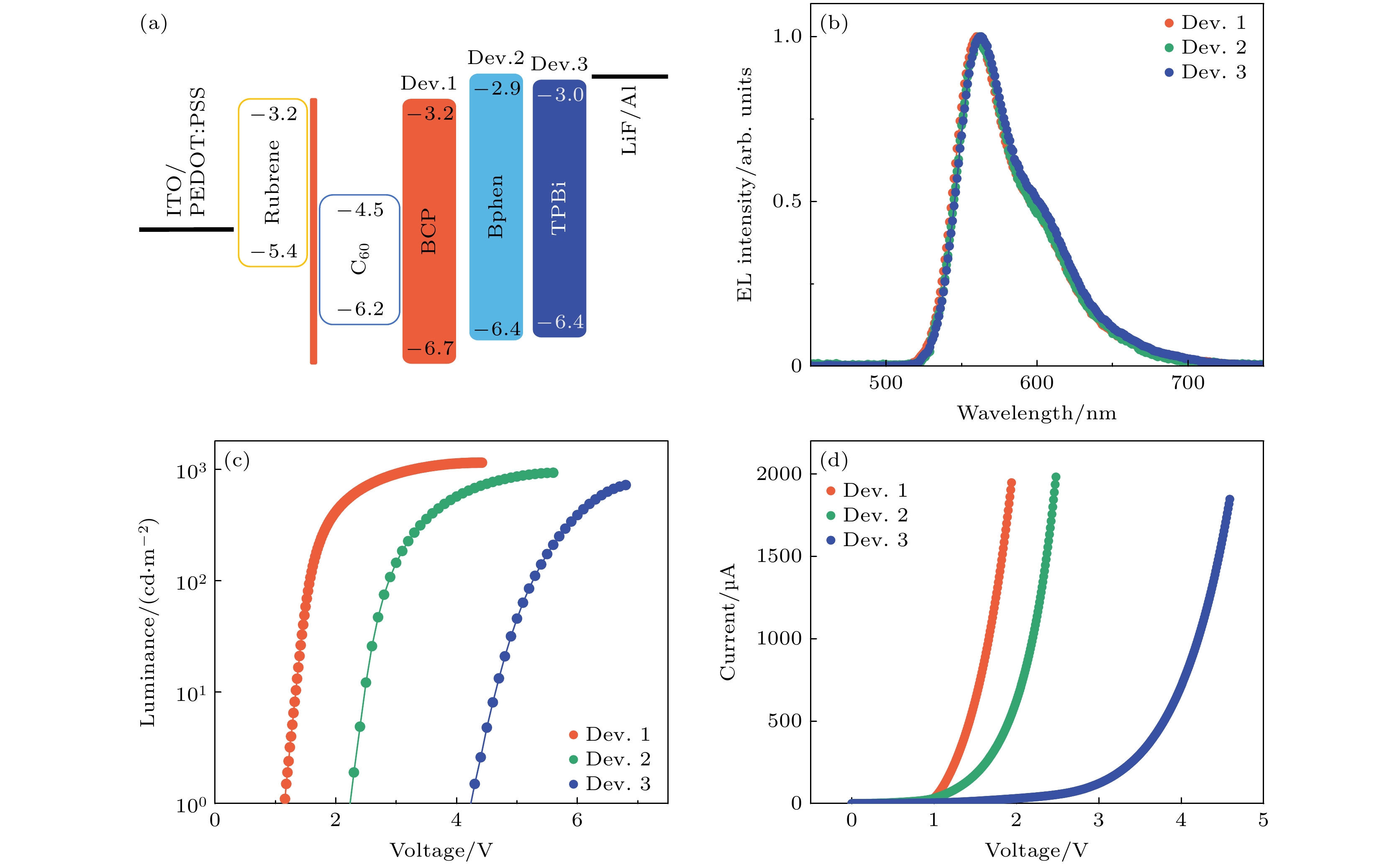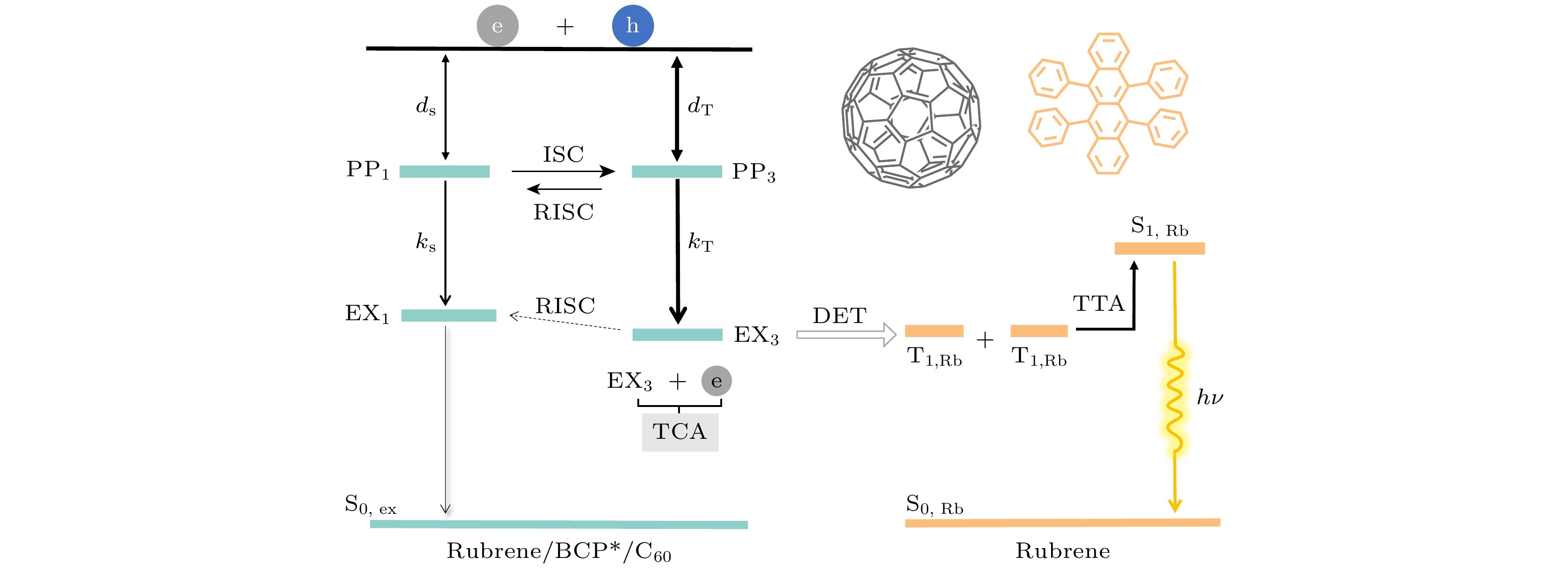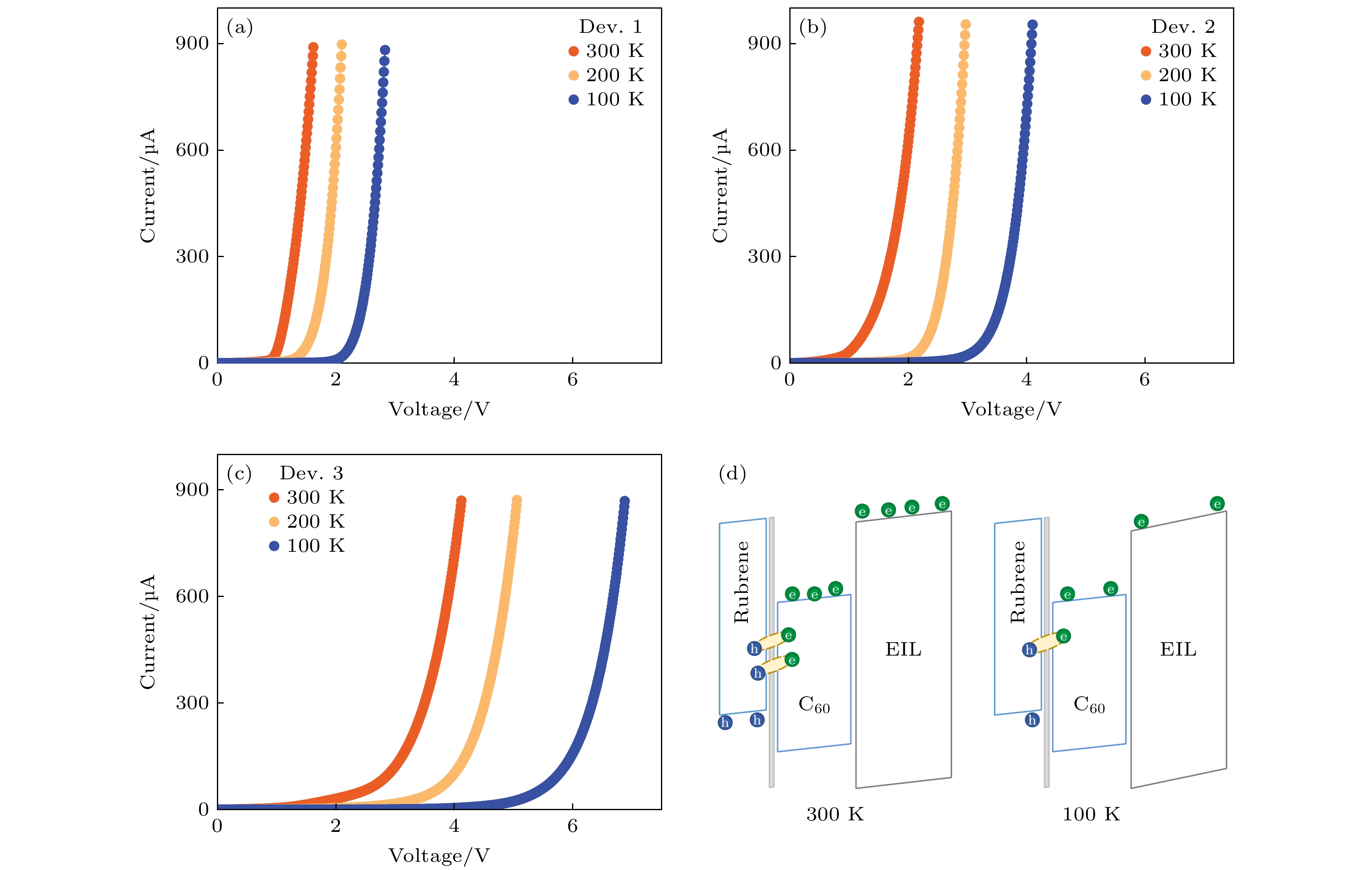-
半带隙开启特性是有机发光二极管独有的一种光电属性, 但电子注入层(electron injection layer, EIL)如何影响半带隙开启的研究还未见报道. 本文选取电子迁移率按数量级依次降低的EIL材料制备了三组控制器件, 发现随EIL电子迁移率的依次降低, 器件的开启电压分别呈现出半带隙(half-band-gap)开启、亚带隙(sub-band-gap)开启和正常开启的物理现象. 器件发光的特征磁效应(magneto-electroluminescence, MEL)结果显示: EIL电子迁移率高的器件实现半带隙开启主要归因于三重态-三重态湮灭(triplet-triplet annihilation, TTA, T1,Rb + T1,Rb → S1,Rb + S0)过程有效降低了器件的开启电压(1.1 V). 但在EIL电子迁移率较低的器件中, 为注入更多电子需要在低电子迁移率的EIL上施加更高的电压, 从而抵消了TTA过程降低的开启电压, 因此随着EIL电子迁移率依次降低其开启电压表现为亚带隙开启(2.1 V)和正常开启(4.1 V). 此外, 高EIL电子迁移率的器件中TTA更强, 亮度更高. 这是由于器件中形成了更多数量的三重激基复合物EX3态并通过Dexter能量传递过程形成T1,Rb. 本工作进一步加深了对Rubrene/C60型器件中电子迁移率对开启电压影响的理解以及相关物理微观机制的认识.Half-band-gap turn-on characteristic is a unique photoelectric property of organic light-emitting diodes (OLEDs), and has advantage in the development of low driving voltage devices. But the physical mechanism that the electron injection layer (EIL) affects the half-band-gap turn-on characteristic has not been reported. In this work, the change from half-band-gap turn-on electroluminescence (EL) to sub-band-gap turn-on EL to normal turn-on EL is observed by regulating the electron mobility of EIL in Rubrene/C60 based devices. Three sets of devices are fabricated by using BCP (~10–3 cm2/(V·s), Dev. 1), Bphen (~10–4 cm2/(V·s), Dev. 2) and TPBi (~10–5 cm2/(V·s), Dev. 3) as EIL materials. By measuring the I-B-V curves of devices at room temperature, it is found that the turn-on voltages of devices obviously increase by an order of magnitude with electron mobility of EIL decreasing. Specifically, the turn-on voltage of Dev. 1, Dev. 2, and Dev. 3 exhibit the physical phenomena of half-band-gap turn-on (1.1 V), sub-band-gap turn-on (2.1 V) and normal turn-on (4.1 V) properties, respectively. The magneto-electroluminescence (MEL) results show that the half-band-gap turn-on characteristic of high EIL electron mobility (Dev. 1) is attributed to the triplet-triplet annihilation (TTA, T1,Rb + T1,Rb → S1,Rb + S0) process which can effectively reduce the turn-on voltage. However, the half-band-gap turn-on characteristic is not observed in the devices (Dev. 2 and Dev. 3) with low carrier mobility, which can be reasonably explained by a higher voltage that is applied to the EIL with low electron mobility in order to inject more electrons. The higher voltage offsets the reduced turn-on voltage of the TTA process, resulting in Dev. 2 and Dev. 3 with sub-band-gap turn-on and normal turn-on, respectively. In addition, although the TTA process is observed in all three devices, the TTA process is stronger and the EL is higher in Dev. 1 with high EIL electron mobility. This is because a large number of triplet Rubrene/C60 exciplex states (EX3) are formed at the Rubrene/C60 interface, enhancing the Dexter energy transfer (DET, EX3 → T1,Rb) process from EX3 to triplet exciton of Rubrene (T1,Rb). That is, Dev. 1 exhibits stronger TTA process and higher EL due to the presence of a large number of T1,Rb excitons formed by DET process than Dev. 2 and Dev. 3. Furthermore, by measuring the I-V curves of devices at low temperature, it is found that the reduced carrier mobility caused by lowering operational temperature increases the turn-on voltages of these three devices. The significantly different increases in the turn-on voltages of Dev. 1–3 at the same low temperature are due to the different influences of temperature on the electron mobility of EIL. The tradeoff between the decrease of carrier mobility and the extension of exciton lifetime makes the MEL curves present different temperature-dependent behaviors. This work further deepens the understanding of the influence of EIL electron mobility on the turn-on voltage and the related physical microscopic mechanism in Rubrene/C60 devices.
-
Keywords:
- organic light-emitting diodes /
- half-band-gap turn-on characteristics /
- electron mobility /
- triplet-triplet annihilation
[1] D’Andrade B W, Esler J, Lin C, Adamovich V, Xia S, Weaver M S, Kwong R, Brown J J 2008 Proc SPIE 7051 70510Q
 Google Scholar
Google Scholar
[2] Reineke S, Lindner F, Schwartz G, Seidler N, Walzer K, Lussem B, Leo K 2009 Nature 459 234
 Google Scholar
Google Scholar
[3] Helander M G, Wang Z B, Qiu J, Greiner M T, Puzzo D P, Liu Z W, Lu Z H 2011 Science 332 944
 Google Scholar
Google Scholar
[4] Komoda T, Yamae K, Kittichungchit V, Tsuji H, Ide N 2012 J. Photopolym. Sci. Technol. 25 321
 Google Scholar
Google Scholar
[5] Pandey A K, Nunzi J M 2007 Adv. Mater. 19 3613
 Google Scholar
Google Scholar
[6] Engmann S, Barito A J, Bittle E G, Giebink N C, Richter L J, Gundlach D J 2019 Nat. Commun. 10 227
 Google Scholar
Google Scholar
[7] Chen Q S, Jia W Y, Chen L X, Yuan D, Zou Y, Xiong Z H 2016 Sci. Rep. 6 25331
 Google Scholar
Google Scholar
[8] Tu L Y, Tang X T, Wang Y, Zhao X, Ma C H, Ye S N, Xiong Z H 2021 Phys. Rev. Appl. 16 064002
 Google Scholar
Google Scholar
[9] Xiang C Y, Peng C, Chen Y, So F 2015 Small 11 5439
 Google Scholar
Google Scholar
[10] He S J, Lu Z H 2016 J. Photonics Energy 6 036001
 Google Scholar
Google Scholar
[11] Tang X T, Hu Y Q, Jia W Y, Pan R H, Deng J Q, He Z H, Xiong Z H 2018 ACS Appl. Mater. Interfaces 10 1948
 Google Scholar
Google Scholar
[12] Yasuda T, Yamaguchi Y, Zou D C, Tsutsui T 2002 Jpn. J. Appl. Phys. 41 5626
 Google Scholar
Google Scholar
[13] Wang Y P, Li B, Jiang C, Fang Y, Bai P, Wang Y 2021 J. Phys. Chem. C 125 16753
 Google Scholar
Google Scholar
[14] Hung W Y, Ke T H, Lin Y T, Wu C C, Hung T H, Chao T C, Wong K T, Wu C I 2006 Appl. Phys. Lett. 88 064102
 Google Scholar
Google Scholar
[15] Niu L B, Zhang Y, Chen L J, Zhang Q M, Guan Y X 2020 Org. Electron. 87 105971
 Google Scholar
Google Scholar
[16] Jin P F, Zhou Z Y, Wang H, Hao J J, Chen R, Wang J Y, Zhang C 2022 J. Phys. Chem. Lett. 13 2516
 Google Scholar
Google Scholar
[17] 吴雨廷, 朱洪强, 魏福贤, 王辉耀, 陈敬, 宁亚茹, 吴凤娇, 陈晓莉, 熊祖洪 2022 物理学报 71 227201
 Google Scholar
Google Scholar
Wu Y T, Zhu H Q, Wei F X, Wang H Y, Chen J, Ning Y R, Wu F J, Chen X L, Xiong Z H 2022 Acta Phys. Sin. 71 227201
 Google Scholar
Google Scholar
[18] Bai J W, Chen P, Lei Y L, Zhang Y, Zhang Q M 2014 Org. Electron. 15 169
 Google Scholar
Google Scholar
[19] Piland G B, Burdett J J, Kurunthu D, Bardeen C J 2013 J. Phys. Chem. C 117 1224
 Google Scholar
Google Scholar
[20] Crooker S A, Liu F, Kelley M R, Martinez N J D, Nie W, Mohite A, Nayyar I H, Tretiak S, Smith D L, Ruden P P 2014 Appl. Phys. Lett. 105 153304
 Google Scholar
Google Scholar
[21] Geng R, Subedi R C, Luong H M, Pham M T, Huang W C, Li X G, Hong K L, Shao M, Xiao K, Hornak L A, Nguyen T D 2018 Phys. Rev. Lett. 120 086602
 Google Scholar
Google Scholar
[22] Hosokawa C, Tokailin H, Higashi H, Kusumoto T 1992 Appl. Phys. Lett. 60 1220
 Google Scholar
Google Scholar
[23] 黄维, 密保秀, 高志强 2011 有机电子学 (北京: 科学出版社) 第300页
Huang W, Mi B X, Gao Z Q 2011 Organic Electronic (Beijing: Science Press) p300
[24] Park B, In I, Gopalan P, Evans P G, King S, Lyman P F 2008 Appl. Phys. Lett. 92 133302
 Google Scholar
Google Scholar
[25] Kobayashi S, Takenobu T, Mori S, Fujiwara A, Iwasa Y 2003 Sci. Technol. Adv. Mater. 4 371
 Google Scholar
Google Scholar
[26] Peng Q, Chen P, Li F 2013 Appl. Phys. Lett. 102 023301
 Google Scholar
Google Scholar
[27] Qiao X F, Yuan P S, Ma D G, Ahamad T, Alshehri S M 2017 Org. Electron. 46 1
 Google Scholar
Google Scholar
[28] Lei Y L, Zhang Y, Liu R, Chen P, Song Q L 2009 Org. Electron. 10 889
 Google Scholar
Google Scholar
[29] Liu Y, Wu X M, Zhao Z H, Gao J N, Zhan J, Rui H S, Lin X, Zhang N, Hua Y L, Yin S G 2017 Appl. Surf. Sci. 413 302
 Google Scholar
Google Scholar
[30] Tang X T, Pan R H, Zhao X, Jia W Y, Wang Y, Ma C H 2020 Adv. Funct. Mater. 5 765
 Google Scholar
Google Scholar
[31] 王辉耀, 宁亚茹, 吴凤娇, 赵茜, 陈敬, 朱洪强, 魏福贤, 吴雨廷, 熊祖洪 2022 物理学报 71 217201
 Google Scholar
Google Scholar
Wang H Y, Ning Y R, Wu F J, Zhao X, Chen J, Zhu H Q, Wei F X, Wu Y T, Xiong Z H 2022 Acta Phys. Sin. 71 217201
 Google Scholar
Google Scholar
[32] Wang Y, Ning Y R, Wu F G, Chen J, Chen X L, Xiong Z H 2022 Adv. Funct. Mater. 32 2202882
 Google Scholar
Google Scholar
[33] 宁亚茹, 赵茜, 汤仙童, 陈敬, 吴凤娇, 贾伟尧, 陈晓莉, 熊祖洪 2022 物理学报 71 087201
 Google Scholar
Google Scholar
Ning Y R, Zhao X, Tang X T, Chen J, Wu F J, Jia W R, Chen X L, Xiong Z H 2022 Acta Phys. Sin. 71 087201
 Google Scholar
Google Scholar
[34] Peng Q M, Li A W, Fan Y X, Chen P, Li F 2014 J. Mater. Chem. C 2 6264
 Google Scholar
Google Scholar
[35] 陈秋松, 袁德, 贾伟尧, 陈历相, 邹越, 向杰, 陈颖冰, 张巧明, 熊祖洪 2015 物理学报 64 177801
 Google Scholar
Google Scholar
Chen Q S, Yuan D, Jia W Y, Chen L X, Zou Y, Xiang J, Chen Y B, Zhang Q M, Xiong Z H 2015 Acta Phys. Sin. 64 177801
 Google Scholar
Google Scholar
-
表 1 器件1—3的具体结构
Table 1. Specific structure of devices 1–3.
Device name Structure Dev. 1 ITO/PEDOT:PSS/Rubrene (35 nm)/BCP (3 nm)/C60 (50 nm)/BCP (10 nm)/LiF (1 nm)/Al (100 nm) Dev. 2 ITO/PEDOT:PSS/Rubrene (35 nm)/BCP (3 nm)/C60 (50 nm)/Bphen (10 nm)/LiF (1 nm)/Al (100 nm) Dev. 3 ITO/PEDOT:PSS/Rubrene (35 nm)/BCP (3 nm)/C60 (50 nm)/TPBi (10 nm)/LiF (1 nm)/Al (100 nm) -
[1] D’Andrade B W, Esler J, Lin C, Adamovich V, Xia S, Weaver M S, Kwong R, Brown J J 2008 Proc SPIE 7051 70510Q
 Google Scholar
Google Scholar
[2] Reineke S, Lindner F, Schwartz G, Seidler N, Walzer K, Lussem B, Leo K 2009 Nature 459 234
 Google Scholar
Google Scholar
[3] Helander M G, Wang Z B, Qiu J, Greiner M T, Puzzo D P, Liu Z W, Lu Z H 2011 Science 332 944
 Google Scholar
Google Scholar
[4] Komoda T, Yamae K, Kittichungchit V, Tsuji H, Ide N 2012 J. Photopolym. Sci. Technol. 25 321
 Google Scholar
Google Scholar
[5] Pandey A K, Nunzi J M 2007 Adv. Mater. 19 3613
 Google Scholar
Google Scholar
[6] Engmann S, Barito A J, Bittle E G, Giebink N C, Richter L J, Gundlach D J 2019 Nat. Commun. 10 227
 Google Scholar
Google Scholar
[7] Chen Q S, Jia W Y, Chen L X, Yuan D, Zou Y, Xiong Z H 2016 Sci. Rep. 6 25331
 Google Scholar
Google Scholar
[8] Tu L Y, Tang X T, Wang Y, Zhao X, Ma C H, Ye S N, Xiong Z H 2021 Phys. Rev. Appl. 16 064002
 Google Scholar
Google Scholar
[9] Xiang C Y, Peng C, Chen Y, So F 2015 Small 11 5439
 Google Scholar
Google Scholar
[10] He S J, Lu Z H 2016 J. Photonics Energy 6 036001
 Google Scholar
Google Scholar
[11] Tang X T, Hu Y Q, Jia W Y, Pan R H, Deng J Q, He Z H, Xiong Z H 2018 ACS Appl. Mater. Interfaces 10 1948
 Google Scholar
Google Scholar
[12] Yasuda T, Yamaguchi Y, Zou D C, Tsutsui T 2002 Jpn. J. Appl. Phys. 41 5626
 Google Scholar
Google Scholar
[13] Wang Y P, Li B, Jiang C, Fang Y, Bai P, Wang Y 2021 J. Phys. Chem. C 125 16753
 Google Scholar
Google Scholar
[14] Hung W Y, Ke T H, Lin Y T, Wu C C, Hung T H, Chao T C, Wong K T, Wu C I 2006 Appl. Phys. Lett. 88 064102
 Google Scholar
Google Scholar
[15] Niu L B, Zhang Y, Chen L J, Zhang Q M, Guan Y X 2020 Org. Electron. 87 105971
 Google Scholar
Google Scholar
[16] Jin P F, Zhou Z Y, Wang H, Hao J J, Chen R, Wang J Y, Zhang C 2022 J. Phys. Chem. Lett. 13 2516
 Google Scholar
Google Scholar
[17] 吴雨廷, 朱洪强, 魏福贤, 王辉耀, 陈敬, 宁亚茹, 吴凤娇, 陈晓莉, 熊祖洪 2022 物理学报 71 227201
 Google Scholar
Google Scholar
Wu Y T, Zhu H Q, Wei F X, Wang H Y, Chen J, Ning Y R, Wu F J, Chen X L, Xiong Z H 2022 Acta Phys. Sin. 71 227201
 Google Scholar
Google Scholar
[18] Bai J W, Chen P, Lei Y L, Zhang Y, Zhang Q M 2014 Org. Electron. 15 169
 Google Scholar
Google Scholar
[19] Piland G B, Burdett J J, Kurunthu D, Bardeen C J 2013 J. Phys. Chem. C 117 1224
 Google Scholar
Google Scholar
[20] Crooker S A, Liu F, Kelley M R, Martinez N J D, Nie W, Mohite A, Nayyar I H, Tretiak S, Smith D L, Ruden P P 2014 Appl. Phys. Lett. 105 153304
 Google Scholar
Google Scholar
[21] Geng R, Subedi R C, Luong H M, Pham M T, Huang W C, Li X G, Hong K L, Shao M, Xiao K, Hornak L A, Nguyen T D 2018 Phys. Rev. Lett. 120 086602
 Google Scholar
Google Scholar
[22] Hosokawa C, Tokailin H, Higashi H, Kusumoto T 1992 Appl. Phys. Lett. 60 1220
 Google Scholar
Google Scholar
[23] 黄维, 密保秀, 高志强 2011 有机电子学 (北京: 科学出版社) 第300页
Huang W, Mi B X, Gao Z Q 2011 Organic Electronic (Beijing: Science Press) p300
[24] Park B, In I, Gopalan P, Evans P G, King S, Lyman P F 2008 Appl. Phys. Lett. 92 133302
 Google Scholar
Google Scholar
[25] Kobayashi S, Takenobu T, Mori S, Fujiwara A, Iwasa Y 2003 Sci. Technol. Adv. Mater. 4 371
 Google Scholar
Google Scholar
[26] Peng Q, Chen P, Li F 2013 Appl. Phys. Lett. 102 023301
 Google Scholar
Google Scholar
[27] Qiao X F, Yuan P S, Ma D G, Ahamad T, Alshehri S M 2017 Org. Electron. 46 1
 Google Scholar
Google Scholar
[28] Lei Y L, Zhang Y, Liu R, Chen P, Song Q L 2009 Org. Electron. 10 889
 Google Scholar
Google Scholar
[29] Liu Y, Wu X M, Zhao Z H, Gao J N, Zhan J, Rui H S, Lin X, Zhang N, Hua Y L, Yin S G 2017 Appl. Surf. Sci. 413 302
 Google Scholar
Google Scholar
[30] Tang X T, Pan R H, Zhao X, Jia W Y, Wang Y, Ma C H 2020 Adv. Funct. Mater. 5 765
 Google Scholar
Google Scholar
[31] 王辉耀, 宁亚茹, 吴凤娇, 赵茜, 陈敬, 朱洪强, 魏福贤, 吴雨廷, 熊祖洪 2022 物理学报 71 217201
 Google Scholar
Google Scholar
Wang H Y, Ning Y R, Wu F J, Zhao X, Chen J, Zhu H Q, Wei F X, Wu Y T, Xiong Z H 2022 Acta Phys. Sin. 71 217201
 Google Scholar
Google Scholar
[32] Wang Y, Ning Y R, Wu F G, Chen J, Chen X L, Xiong Z H 2022 Adv. Funct. Mater. 32 2202882
 Google Scholar
Google Scholar
[33] 宁亚茹, 赵茜, 汤仙童, 陈敬, 吴凤娇, 贾伟尧, 陈晓莉, 熊祖洪 2022 物理学报 71 087201
 Google Scholar
Google Scholar
Ning Y R, Zhao X, Tang X T, Chen J, Wu F J, Jia W R, Chen X L, Xiong Z H 2022 Acta Phys. Sin. 71 087201
 Google Scholar
Google Scholar
[34] Peng Q M, Li A W, Fan Y X, Chen P, Li F 2014 J. Mater. Chem. C 2 6264
 Google Scholar
Google Scholar
[35] 陈秋松, 袁德, 贾伟尧, 陈历相, 邹越, 向杰, 陈颖冰, 张巧明, 熊祖洪 2015 物理学报 64 177801
 Google Scholar
Google Scholar
Chen Q S, Yuan D, Jia W Y, Chen L X, Zou Y, Xiang J, Chen Y B, Zhang Q M, Xiong Z H 2015 Acta Phys. Sin. 64 177801
 Google Scholar
Google Scholar
计量
- 文章访问数: 3420
- PDF下载量: 92
- 被引次数: 0














 下载:
下载:





